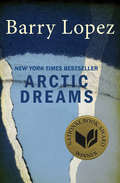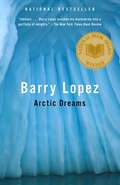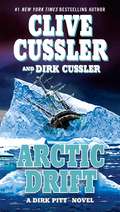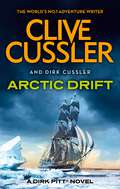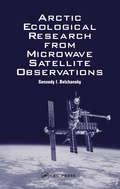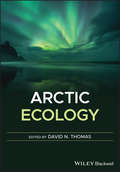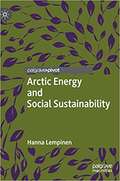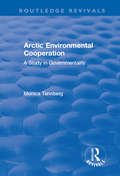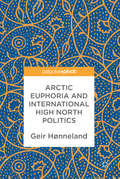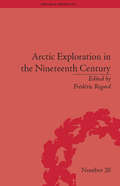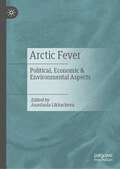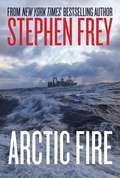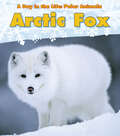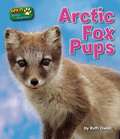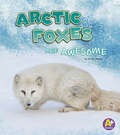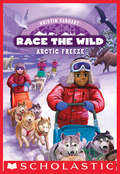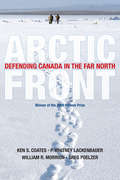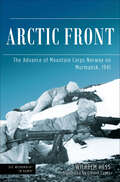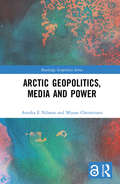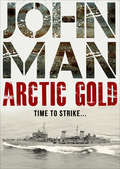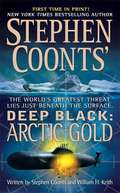- Table View
- List View
Arctic Dreams: Imagination And Desire In A Northern Landscape (Read-On)
by Barry LopezThis New York Times–bestselling exploration of the Arctic, a National Book Award winner, is &“one of the finest books ever written about the far North&” (Publishers Weekly). &“The nation&’s premier nature writer&” travels to a landscape at once barren and beautiful, perilous and alluring, austere yet teeming with vibrant life, and shot through with human history (San Francisco Chronicle). The Arctic has for centuries been a destination for the most ambitious explorers—a place of dreams, fears, and awe-inspiring spectacle. This &“dazzling&” account by the author of Of Wolves and Men takes readers on a breathtaking journey into the heart of one of the world&’s last frontiers (The New York Times). Based on Barry Lopez&’s years spent traveling the Arctic regions in the company of Eskimo hunting parties and scientific expeditions alike, Arctic Dreams investigates the unique terrain of the human mind, thrown into relief against the vastness of the tundra and the frozen ocean. Eye-opening and profoundly moving, it is a magnificent appreciation of how wilderness challenges and inspires us. Renowned environmentalist and author of Desert Solitaire Edward Abbey has called Arctic Dreams &“a splendid book . . . by a man who is both a first-rate writer and an uncompromising defender of the wild country and its native inhabitants&”—and the New Yorker hails it as a &“landmark&” work of travel writing. A vivid, thoughtful, and atmospheric read, it has earned multiple prizes, including the National Book Award, the Christopher Medal, the Oregon Book Award, and a nomination for the National Book Critics Circle Award. This ebook features an illustrated biography of Barry Lopez including rare images and never-before-seen documents from the author&’s personal collection.
Arctic Dreams: Imagination and Desire in a Northern Landscape
by Barry Holstun LopezThis National Book Award winner examines the Far North - its terrain, wildlife, and history of the Eskimo natives and intrepid explorers who arrived on its icy shores. What turns this compendium of biology, anthropology and history into a breathtaking study of profound originality is Lopez's unique meditation on how the landscape can shape our imagination, desires and dreams.
Arctic Drift (Dirk Pitt #20)
by Clive Cussler Dirk CusslerA foundered Victorian ship looking for the fabled Northwest Passage holds a secret in its icy grave... <P><P>When Dirk Pitt of NUMA is almost blown to pieces in a lab explosion, he suspects sabotage. The lab in question belongs to a scientist hoping to use a rare mineral to combat greenhouse gases - but who would want to destroy our one chance to save the planet? <P><P>However, there are those who will do anything to control such a valuable prize. Pitt's investigations take him to the Arctic in search of a clue to the origins of this precious mineral. There he and NUMAr colleague Al Giordino must battle for survival against the hostile elements and evil megalomaniac who is about to plunge the North American continent into war... <P><P> Artic Drift is a white-knuckle ride of a novel that once picked up you won't want to put it down.
Arctic Drift: Dirk Pitt #20 (Dirk Pitt Adventures #20)
by Clive Cussler Dirk CusslerA foundered Victorian ship looking for the fabled Northwest Passage holds a secret in its icy grave . . .When Dirk Pitt of NUMA is almost blown to pieces in a lab explosion, he suspects sabotage. The lab in question belongs to a scientist hoping to use a rare mineral to combat greenhouse gases - but who would want to destroy our one chance to save the planet?But there are those who will do anything to control such a valuable prize. Pitt's investigations take him to the Arctic in search of a clue to the origins of this precious mineral. There he and NUMA colleague Al Giordino must battle for survival against the hostile elements and an evil megalomaniac who is about to plunge the North American continent into war . . .Arctic Drift is a white-knuckle ride of a novel that sees Clive Cussler's greatest hero, Dirk Pitt, fighting his enemies in the cruel Arctic.Praise for Clive Cussler'Clive Cussler is hard to beat' Daily Mail'Clive Cussler is the guy I read' Tom Clancy'The Adventure King' Daily Express
Arctic Drift: Dirk Pitt #20 (Dirk Pitt Adventures #20)
by Clive Cussler Dirk CusslerA foundered Victorian ship looking for the fabled Northwest Passage holds a secret in its icy grave . . .When Dirk Pitt of NUMA is almost blown to pieces in a lab explosion, he suspects sabotage. The lab in question belongs to a scientist hoping to use a rare mineral to combat greenhouse gases - but who would want to destroy our one chance to save the planet?But there are those who will do anything to control such a valuable prize. Pitt's investigations take him to the Arctic in search of a clue to the origins of this precious mineral. There he and NUMA colleague Al Giordino must battle for survival against the hostile elements and an evil megalomaniac who is about to plunge the North American continent into war . . .Arctic Drift is a white-knuckle ride of a novel that sees Clive Cussler's greatest hero, Dirk Pitt, fighting his enemies in the cruel Arctic.Praise for Clive Cussler'Clive Cussler is hard to beat' Daily Mail'Clive Cussler is the guy I read' Tom Clancy'The Adventure King' Daily Express
Arctic Ecological Research from Microwave Satellite Observations
by Gennady I. BelchanskyActive (imaging radar) and passive (radiometer) microwave systems are increasingly used for Arctic ecological research. Unfortunately, until now ecologists interested in remote sensing often lacked access to the full suite of physical and analytical techniques of microwave systems, data processing, and ecological applications because a suitable ref
Arctic Ecology
by David N. ThomasThe Arctic is often portrayed as being isolated, but the reality is that the connectivity with the rest of the planet is huge, be it through weather patterns, global ocean circulation, and large-scale migration patterns to name but a few. There is a huge amount of public interest in the ‘changing Arctic’, especially in terms of the rapid changes taking place in ecosystems and exploitation of resources. There can be no doubt that the Arctic is at the forefront of the international environmental science agenda, both from a scientific aspect, and also from a policy/environmental management perspective. This book aims to stimulate a wide audience to think about the Arctic by highlighting the remarkable breadth of what it means to study its ecology. Arctic Ecology seeks to systematically introduce the diverse array of ecologies within the Arctic region. As the Arctic rapidly changes, understanding the fundamental ecology underpinning the Arctic is paramount to understanding the consequences of what such change will inevitably bring about. Arctic Ecology is designed to provide graduate students of environmental science, ecology and climate change with a source where Arctic ecology is addressed specifically, with issues due to climate change clearly discussed. It will also be of use to policy-makers, researchers and international agencies who are focusing on ecological issues and effects of global climate change in the Arctic. About the Editor David N. Thomas is Professor of Arctic Ecosystem Research in the Faculty of Biological and Environmental Sciences, University of Helsinki. Previously he spent 24 years in the School of Ocean Sciences, Bangor University, Wales. He studies marine systems, with a particular emphasis on sea ice and land-coast interactions in the Arctic and Southern Oceans as well as the Baltic Sea. He also edited a related book: Sea Ice, 3rd Edition (2017), which is also published by Wiley-Blackwell.
Arctic Energy and Social Sustainability
by Hanna Lempinen<p>In recent years the Arctic has become the focus of political, popular and scholarly debates around the future of our world’s Energy. Increasing consumption, dwindling reserves, climate warming and developing technologies are expected to push energy-related activities ever further into the previously inaccessible north. Within this framework, energy in the Arctic is predominantly understood as synonymous with oil and gas production for international exports; meanwhile, any social sustainability concerns associated with energy-related developments remain largely neglected or reduced to regional socioeconomic concerns. <p>Lempinen adopts an alternative approach, exploring how energy and its societal aspects are defined and debated in the context of the circumpolar north. Combining an in-depth conceptual discussion on energy and the social dimension of sustainability with an empirical focus on the scientific and political “truths” produced about energy and society in the Arctic energyscape, this book is an enlightening read for students, scholars and professionals interested in issues related to energy and society in the Arctic or beyond.</p>
Arctic Environmental Cooperation: A Study in Governmentality (Routledge Revivals Ser.)
by Monica TennbergThis title was first published in 2000: The book analyses the development of arctic environmental cooperation since the late 1980s until the establishment of the Arctic Council in 1996. The study is based on the discourse analysis of statement, documents and interviews by the different actors in the cooperation. In this book, the problem of the environment is seen as a problem of order: it is a problem of ordering relations among related actors, of ordering priorities of action and of ordering relations between different institutional arrangements locally, regionally and internally. Three discourses were found in the cooperation: discourses of sovereignty, knowledge and development. In the discourse of sovereignty, the development of relations between state and indigenous peoples in terms of international environmental cooperation is central. In the discourse of knowledge, the different forms of knowledge and the role of different producers of knowledge in cooperation has been discussed. The discourse of development focuses on the idea of sustainable development and its applications in defining the future of the Circumpolar North and the activities of the Arctic Council. The arctic cooperation can be understood as a regional effort to make an order of sustainability into practice.
Arctic Environmental Modernities: From the Age of Polar Exploration to the Era of the Anthropocene (Palgrave Studies in World Environmental History)
by Lill-Ann Körber Anna Westerståhl Stenport Scott MacKenzieThis book offers a diverse and groundbreaking account of the intersections between modernities and environments in the circumpolar global North, foregrounding the Arctic as a critical space of modernity, where the past, present, and future of the planet’s environmental and political systems are projected and imagined. Investigating the Arctic region as a privileged site of modernity, this book articulates the globally significant, but often overlooked, junctures between environmentalism and sustainability, indigenous epistemologies and scientific rhetoric, and decolonization strategies and governmentality. With international expertise made easily accessible, readers can observe and understand the rise and conflicted status of Arctic modernities, from the nineteenth century polar explorer era to the present day of anthropogenic climate change.
Arctic Euphoria and International High North Politics
by Geir HønnelandThis pivot describes the ups and downs of Norwegian High North politics since the end of the Cold War. It considers how political interest in the Arctic has been growing rapidly in the international community as states stake their claim to areas of the continental shelf in the Arctic Ocean, and focuses on Russia’s actions, as the Arctic state with the longest shoreline and the only one outside NATO. The author argues that among the Western countries, Norway has the most extensive experience in tackling Russia in the Arctic, and the neighbourhood with the Russian Bear invariably shapes foreign policy, notably in matters of security, and how foreign policy concerns are intertwined with economic motives, be that hopes of access to the big Russian market or to the oil and gas fields on the Russian Arctic shelf. To achieve the combined goal of security and business, the Norwegian Government has regularly orchestrated “Arctic waves” to direct the attention of local, national and international politicians and businesses to the alleged opportunities of the North. In this book, the author takes us through “the Great Barents Awakening” of the 1990s, “the Great High North Enchantment” of the early 2000s and recent years’ “Arctic wave” in Norwegian foreign policy.
Arctic Exploration in the Nineteenth Century: Discovering the Northwest Passage (Empires in Perspective)
by Frédéric RegardFocusing on nineteenth-century attempts to locate the northwest passage, the essays in this volume present this quest as a central element of British culture.
Arctic Fever: Political, Economic & Environmental Aspects
by Anastasia LikhachevaThis book explores the Arctic as a rapidly evolving phenomenon in international affairs of a rising number of stakeholders. For decades, Arctic studies used to be an affair of a relatively narrow group of experts from northern countries. This time is over due to a new Chinese Arctic policy, as well as growing regional interests from South Korea, Singapore, India and Japan. Contributors reflect on new roles for the Arctic region: both as a playground for the old school nation state competition and even confrontation, and a new source for international cooperation in energy, logistics and natural sciences. Climate change, political tensions and economic competition make Arctic a hotter venue of international relations. This new Arctic fever, studied through a comparative analysis of different regional agendas, especially with a focus on the US–China–Russia triangle, represents the main subject of our book, which will be of interest to scholars of geopolitics, of climate change, and of 21st century energy economics.
Arctic Fire
by Stephen W. FreyTroy Jensen could do it all: he conquered the Seven Summits, sailed solo around the world twice, and even fought a bull in a Mexican slum on a dare. So when word comes that a rogue wave has swept Troy off a crab fishing boat in the Bering Sea and into a watery grave, his brother, Jack, doesn't buy it. Against his better judgment, Jack decides to quit his job as a Wall Street trader and head to Dutch Harbor, Alaska, to investigate. Minutes after revealing his plan in his father's New York City office, Jack is nearly run down in the street. He doesn't think much of it at the time, but as he digs deeper into Troy's disappearance, Jack unearths information about RED-CELL-SEVEN (RCS), a super-secret American intelligence group that has operated for forty years in almost total secrecy and with complete impunity--and its leaders intend to keep it that way at any cost. An adrenaline-pumping tale of one man's descent into a hellish underworld populated by terrorists, assassins, and very bad "good guys," Arctic Fire explores the disturbing difference between doing what is good and doing what is right when it comes to protecting America from her greatest enemies.
Arctic Fox
by Katie MarsicoFollow an arctic fox through its day as it eats, sleeps, and cares for its young.
Arctic Fox Pups (Wild Baby Animals)
by Ruth OwenArctic fox pups grow up in one of the coldest places on Earth. When they are very small, their parents bring food to them. As they grow, however, their parents teach them how to hunt and find their own food. Look inside to discover all the ways these wild baby animals get ready to become grown-up arctic foxes.
Arctic Fox: Clever Hunter / Fennec Fox: Desert Survivor (Fountas & Pinnell Classroom, Guided Reading)
by Sara Latta Alice McGintyNIMAC-sourced textbook
Arctic Foxes Are Awesome (Polar Animals Ser.)
by Jaclyn JaycoxWhat’s that springing into the air? An Arctic fox! He lands, breaking through the snow. He has caught his lunch. Learn more about Arctic foxes and how they survive in the frigid tundra. Follow them as they search for prey beneath the snow and ice. Find out how fox pups stay safe from roaming predators.
Arctic Freeze (Race the Wild #3)
by Kristin EarhartOn a once-in-a-lifetime race through the animal kingdom, it takes smarts, strength, and skill to win!The air might be freezing, but the race is heating up! Dev can't stop thinking about how much he'd disappointed his dad by signing up for The Wild Life. But to win a race through the frozen Arctic tundra, where animals are ferocious and nature is extreme, the red team needs everyone to give it their all...even Dev! And if he doesn't, his new friends may be giving him the cold shoulder...Each chapter in this action-packed adventure series is bursting with totally true facts about wild and wonderful creatures, dangerous habitats, maps, and more!
Arctic Front: Defending Canada in the Far North
by P. Whitney Lackenbauer Ken S. Coates William R. Morrion Greg PoelzerA hard-hitting, timely, and provocative book about the history and future of the Canadian Arctic. With passion and sharp words, Arctic Front confronts Canada’s longstanding neglect of the Far North and outline what needs to be done to protect our national interest. Through a lively and engaging history of the region, Arctic Front reveals how Canadians and their governments have:ignored this region for generationsexpanded Canadian sovereignty over the past hundred years by reacting to other countries’ challengesbecome the least effective of all Circumpolar nations in responding to the needs of the Arcticneglected our obligations to the North, including a failure to capitalize on the human and economic resources of this vast land or to establish a presence that would make any foreign claims to offshore resources inconceivable.As global warming continues to melt the ice in the Northwest Passage and the competition for northern resources heats up, Canada, the authors warn, will be forced to defend this area from a position of grave weakness. Our leaders need to take action today, blending defence and development, to complete Canadian nation building in this fragile region. An energetic and engaging collaboration by four of Canada’s leading Northern specialists, Arctic Front is a clarion call to all Canadians about our endangered Arctic region, challenging the country to step away from the symbols and myth making of the past and toward the urgent political, environmental and economic realities of the 21st century.
Arctic Front: The Advance of Mountain Corps Norway on Murmansk, 1941 (Die Wehrmacht im Kampf)
by Wilhelm Hess“A very thorough analysis as to why and how the combined German-Finnish army . . . ultimately failed in their quest to seize Murmansk during Barbarossa.” —Globe at WarIn 1941, military operations were conducted by large formations along the northern coast of Scandinavia—for the first time in the history of warfare. The Arctic Front was the northernmost theater in the war waged by Germany against Russia. For a period of four years, German troops from all branches of the Wehrmacht fought side by side with Finnish border guard units.The high point of the war on the Arctic Front was the assembly and advance of Germany’s Mountain Corps Norway in the summer and autumn of 1941. Commanded by general of the mountain troops, Eduard Dietl, and composed of the 2nd and 3rd Mountain Divisions, the Mountain Corps advanced out of occupied North Norway, assembled in the Petsamo Corridor in North Finland, and struck into Russian territory in an attempt to seize Murmansk. It did not reach its objective. This account of the operation was written by Wilhelm Hess, quartermaster of the Mountain Corps Norway. He draws upon his personal experience of the conditions and actions on the Arctic Front in order to describe and analyze the environment, the sequence of events, and the reasons behind certain decisions. In addition to describing how operations conducted by the Mountain Corps unfolded, Hess provides insight as to how the terrain, the flow of supplies, and the war at sea impacted those operations.“A serious, thoughtful book about war . . . in conditions hardly conducive to survival, let alone combat.” —Stone & Stone
Arctic Geopolitics, Media and Power (Routledge Geopolitics Series)
by Miyase Christensen Annika Nilsson E.Arctic Geopolitics, Media and Power provides a fresh way of looking at the potential and limitations of regional international governance in the Arctic region. Far-reaching impacts of climate change, its wealth of resources and potential for new commercial activities have placed the Arctic region into the political limelight. In an era of rapid environmental change, the Arctic provides a complex and challenging case of geopolitical interplay. Based on analyses of how actors from within and outside the Arctic region assert their interests and how such discourses travel in the media, this book scrutinizes the social and material contexts within which new imaginaries, spatial constructs and scalar preferences emerge. It places ground-breaking attention to shifting media landscapes as a critical component of the social, environmental and technological change. It also reflects on the fundamental dilemmas inherent in democratic decision making at a time when an urgent need for addressing climate change is challenged by conflicting interests and growing geopolitical tensions. This book will be of great interest to geography academics, media and communication studies and students focusing on policy, climate change and geopolitics, as well as policy-makers and NGOs working within the environmental sector or with the Arctic region.
Arctic Gold
by John ManA man searches for the sunken treasure he once protected as a sailor in WWII in this “thrilling action story” from the acclaimed historian (Tom Kasey, author of Trade Off). Murmansk, Russia, 1942. The HMS Edinburgh is sailing deep in Russian territory, a bulwark against Nazi invaders. Among the eight-hundred-strong crew is Mike Cox, a sixteen-year-old boy from the East End, London who is about to be thrown into the heat of war. A Russian ship approaches the Edinburgh with a very precious cargo—over a thousand tons of gold—as payment from the Soviet Union for the Royal Navy’s protection. Now the English ship is tasked with safeguarding a fortune as well as the Barents Sea. But when a German U-boat fires torpedoes at the Edinburgh’s hull, the crew must fight for their lives . . . and Mike is one of only a few survivors to escape from the wreck as the gold sinks eight hundred feet to the bottom of the sea. After making his way back to London, Mike finds himself more alone than ever. He starts training to become a diver with one objective in mind: to rescue that precious Arctic gold. But he’ll have to act quick—he’s not the only one looking for it . . .
Arctic Gold (Deep Black #7)
by Stephen Coonts William H. KeithIn the Arctic, two American intelligence operatives are kidnapped while investigating Russian submarines—a constant, covert presence beneath the ice caps. In Washington, ex-Marine Charlie Dean and his team at Desk Three trace the abduction back to the Russian mafiya, who have their sights set on the massive reserves of oil that lie thousands of feet below the ocean's floor. While Dean is sent to the Arctic to rescue the hostages, the beautiful Lia DeFrancesca penetrates a heavily guarded dacha on the shores of the Black Sea. There she learns the explosive truth about Russia and its Arctic oil—one that could cost Dean and his Deep Blackteam their lives...and drive the world's superpowers to the brink of war.
Arctic Governance Through Conferencing: Actors, Agendas and Arenas (Frontiers in International Relations)
by Beate SteinvegThis book examines the functions of conferences within Arctic governance, as a third dimension between sovereign states and formalized cooperative arrangements. It analyzes conferences against the background of three main empirical topics. Firstly, the functions of conferences for different actor groups, both Arctic rights holders and emerging non-Arctic state actors claiming stakeholder status. From this, the book also analyzes how conferences contribute to altering the actor composition of Arctic governance as a whole. Secondly, conferences as agenda setting arenas – whether conference activities can contribute to influencing the broader agenda in the region, and conferences as arenas for agenda setting – whether participants can bring with them topics that are picked up and brought into other processes. Thirdly, the book considers the space for conferences within broader governance architectures, as links between units in the regime complex.The book further presents an in-depth case study of the two largest conferences on Arctic issues: the Arctic Frontiers and Arctic Circle Assembly. It illustrates the diverse functions conferences can have for elements within a broader governance system, beyond serving as meeting places and networking arenas. Therefore, it is a must-read for researchers, students, and policy-makers interested in a better understanding of Arctic governance in particular, and International Relations in general.
